Attendees were separated into different rooms. Seven scientists rotate through each room, switching out every seven minutes, giving attendees a glimpse into compelling worlds. It is just like “speed dating,” but with a more intellectual kind of romance.
Afterward, writer/director/producer Wendy Calhoun hosted an excellent Q and A session.
Here were our seven “dates”:
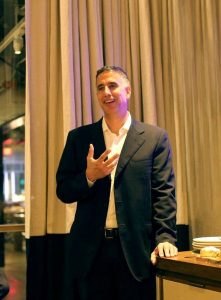
Jody Puglisi
Profession: Structural Biology Professor, Stanford
Interest: The role of ribonucleic acids in promoting health and fighting disease
Highlight: An example of how simple microscopic pictures can lead to wide, societal benefits.
Takeaway: Puglisi takes highly detailed pictures of molecules. Why? Right now, the fight against infectious diseases is greatly hampered by rising antibiotic resistance. So, we need to create new antibiotics. Doing so is like creating a fake set of keys for a very complicated, particular lock. In order to make those keys, we need a detailed picture of that keyhole. By capturing every single microscopic detail of a molecule, we can truly understand the molecule. And when we thoroughly understand the shape of the molecule, we can better understand its function and, therefore, figure out how to interfere with it. The solution, it seems, is in the details.
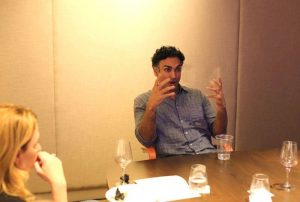
Rahul Jandial
Profession: Brain Surgeon and Neuroscientist, City of Hope LA
Interest: Saving lives
Highlight: A story about his first patient death: a woman who he kept alive for close to a month, after she was involved in a motor vehicle accident. Initial efforts included drilling into her swollen cranium to give the brain room to breath, thereby preventing brain death. The patient eventually died; in the following 12-month period, 24 additional patients died. “The patients: they wreck you.”
Takeaway: It might seem futile; why prolong a life that is so obviously about to be lost? It comes down to this: you either die in the streets or you die in a hospital with your family and loved ones at your bedside. All that effort made by surgeons, nurses, and assorted health care professionals might not be to save the life, but to prolong it just enough to give your loved ones a chance to say goodbye. And that means something. Or, at least, you have to tell yourself that it does.
DaNel Hogan
Profession: STEM educator; Director of The STEMAZing Project
Interest: Spreading the gospel on the importance of STEM (science, technology, engineering, and mathematics) education, primarily through #STEMonthecheap
Highlight: Showcasing how anyone can do fun science projects on the cheap.
Things to Google (and try!!):
- Macro Lens: turn your phone into a microscope
- Pyramid Projector: turn your phone into a hologram platform
- Welded Ring + Pull Chain: drop the ring over the chain in such a way that it automatically catches. To be said in a falsetto voice: Physics!
- Check out www.stemazing.org
Takeaway: It starts with empowering teachers: a teacher with a negative attitude toward science has a devastating impact on his/her students’ view on science. At first glance, there is nothing particularly impressive about doing easy and cheap science experiments. But then Hogan spoke about its rippling effects: children build STEM identities much earlier than we realize; so if you can teach STEM lessons on the cheap, if you can make it accessible as well as engaging, the potential benefits are enormous. Suddenly, poor students attending neglected public schools can have a chance at looking through a makeshift microscope. By no means should that be a lasting solution, but in this reality, it is better than nothing. This is not just about conducting fun science tricks; this is about equality and social justice, about giving every child an equal opportunity to be awed and inspired.
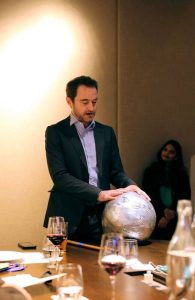
Kevin Hand
Profession: Planetary Scientist and Astrobiologist, NASA’s Jet Propulsion Laboratory
Interest: The origin, evolution, and distribution of life in the solar system
Highlight: An example of how scientists discovered the very strong possibility of an underground ocean on Europa, one of Jupiter’s moons. This implication is important because liquid water tends to indicate “life.” So, how do you discover an alien ocean? By using spectroscopy and a study of the moon’s gravity and magnetic fields.
When the Galileo probe flew by the Jovian moon in the 1990s, scientists noted that Europa had an induced magnetic field, created by its relatively constant interaction with Jupiter; such a field is possible when there is an all-encompassing, low-density substance that has electrical conductivity. So, what’s a prime candidate for this substance? Salty water.
Fun fact: Europa’s underground ocean has two to three times the volume of all of the liquid water on Earth, with the tug and pull of its orbit around Jupiter keeping the water liquid and churning.
Takeaway: Europa; Saturn’s moons; sub-surface Mars. In the solar system, these are some of the prime candidates for discovering life, which Hand predicts (not believes!) could happen in the next 20 years. To define “life,” we need a second example of “life,” something to compare to our definition of “life.”
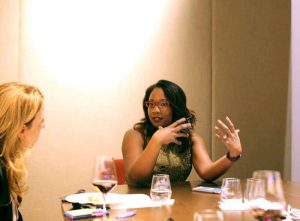
Talithia Williams
Profession: Associate Professor of Mathematics, Harvey Mudd College
Interest: Using statistics as a way of seeing the world in a new light
Highlight: How do you use data? An example of Williams’s work: during the 2015 Baltimore protests, researchers studied protestors’ tweets. They could predict the “climax” of the protest by studying and tracking “negative” words. Furthermore, they could use these “negative” words to map out the geographical concentration of these protests. Are there any future applications for law enforcement and how it might affect an American citizen’s right to assembly? For now, mum’s the word.
Takeaway: Imagine a mathematician or statistician. What kind of person do you see? Most likely, it is not Williams, an African-American woman working in a field that is dominated by older, white men. So, the takeaway from Williams, surprisingly, is not about statistics or mathematics. It is personal, social, and very much prevalent to today’s America. The very fact that Williams is such a rare figure in her field, dealing with struggles that very few of us can really understand, speaks volumes about the systematic obstacles that people of color, let alone women, have to surmount. And so like others before her, Williams reminds the Hollywood community to recognize the power of images. By showcasing more people (especially females!) of color on screen, doing jobs that were historically held by white men, we can show young minorities that there is a way. And, more importantly, we can eliminate the excuse “I failed because I am black.”
Eric Schulze
Profession: Senior Scientist, Memphis Meats
Interest: Science communication with the public; molecular biology
Highlight: Schulze grows meat. Grows. How? Very simply put: Meat is protein and protein can be grown in a laboratory. The needle used to give a cow a vaccination has leftover muscle cells that can be used to grow more meat.
Think about the food chain and its decreasing efficiency as we move along it. Plants take in sunlight and water to grow, but they do not convert all of the solar energy they take in, resulting in photosynthetic efficiency of around 10 percent. Moving up the food chain: cows, which eat plants (before moving on to the grain feed yard) are even less efficient. So by the time a piece of meat reaches our plate, all of the compounding inefficiencies lead to a meal that was environmentally costly to produce. Compound that with multiple meals per day, per person, and the costs skyrocket.
Takeaway: Schulze’s goal is to eliminate livestock and make meat production sustainable (if we eliminate one-third of the world’s cows, it would be equivalent to taking all the world’s cars off the road tomorrow). At first, that might sound like a paradox, but it’s a viable—and potentially planet-saving—goal. There are talks of increasing gas mileage, shifting to electric cars, recycling, or just encouraging people to turn off their lights. But all of these are incremental changes, with little attention paid to one of the largest contributors to greenhouse gas emissions: agriculture.
It comes down to individual actions to combat climate change. By rethinking how we produce our meat and accepting its potentially new origins, we can do good for the environment and still be meat-eaters at the same time.
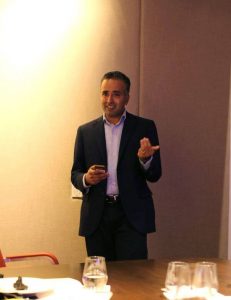
Karthick Ramakrishnan
Profession: Associate Dean, University of California, Riverside, School of Public Policy; Professor of Public Policy and Political Science
Interest: Civic participation, immigration policy, and the politics of race, ethnicity, and immigration in the United States
Highlights: There are 42 million immigrants in the United States or about 13 percent of the national population. Around the world, there are 240 million immigrants; so, about one in six immigrants in the world lives in the United States.
The facts are interesting and unexpected: contrary to current political rhetoric, we actually have net zero Mexican immigration, as more are leaving for Mexico than actually coming into the United States. In fact, since 2007, more immigrants have come from Asia than Latin America.
Takeaway: The immigrant story is a fundamental part of global society and it will become increasingly prevalent. Unfortunately, that story is constantly misunderstood: news follows politicians’ actions and it consistently fails to correct misconceptions that are rooted in fear, hatred, or misinformation. So, while immigration can be an emotional and political issue, it is vital to understand that it is a complex, multi-layered story that deserves a proper study of the facts as well as a much-needed dose of humanity.






